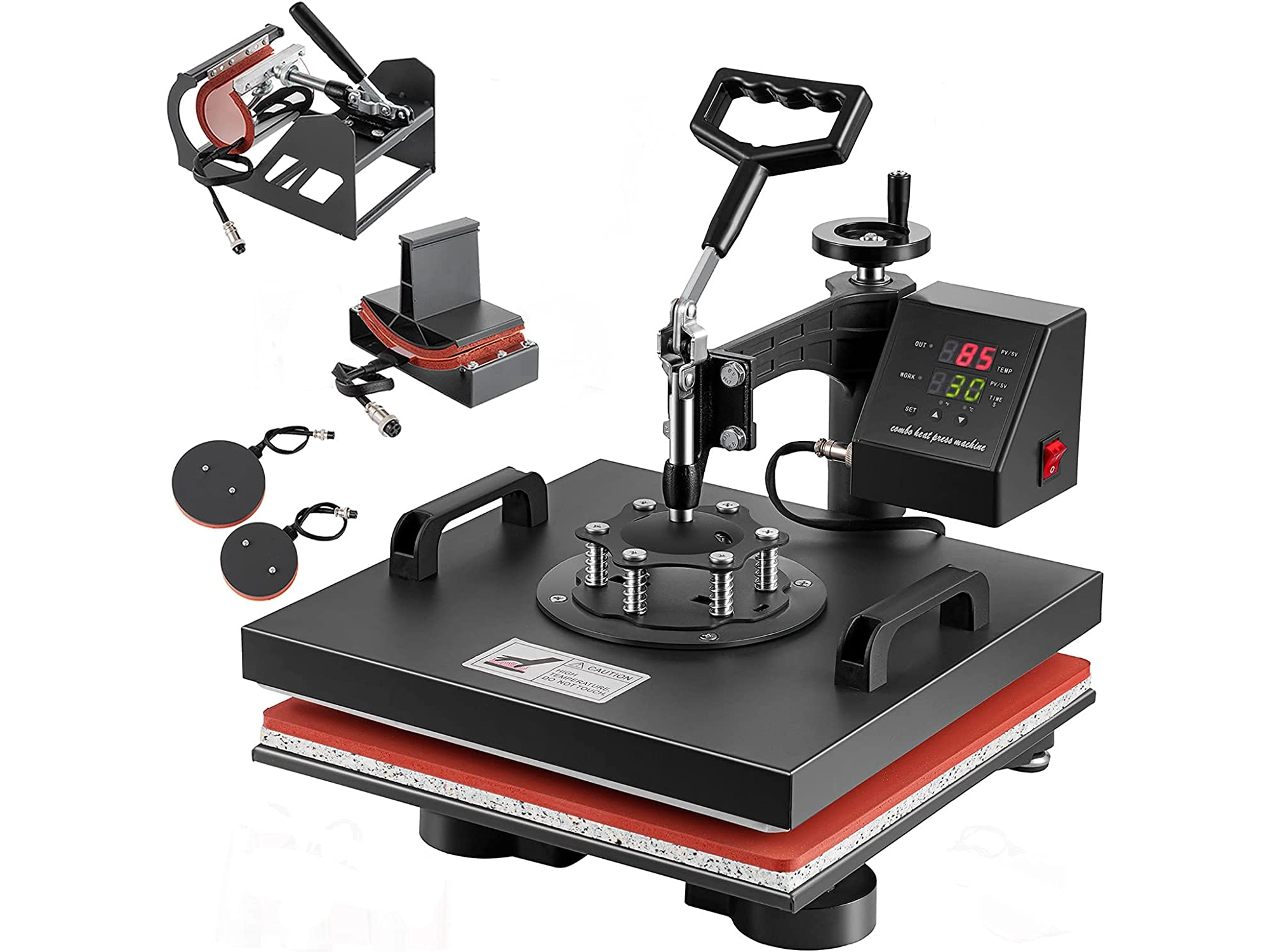Sublimation transfer only works on polyester and polymer-coated materials. HTV (Heat Transfer Vinyl) works on a wider range of materials.

A heat press machine is used to transfer designs onto a variety of substrates by applying heat and pressure. The 5 in 1 heat press machine has the ability to press onto T-shirts, caps, ceramic plates, ceramic tiles, mugs, coasters, jigsaw puzzles, lettering, and other miscellaneous fabrics and materials.
Risks
- Burns: The heat plate can become extremely hot and cause burns if touched without proper protective gear.
- Fire: The heat plate and other components of the machine can become a fire hazard if left unattended.
Glossary
- Heat Press: A machine that uses heat and pressure to transfer designs, images or graphics onto various materials, such as t-shirts, caps, ceramic plates, ceramic tiles, mugs, coasters, jigsaw puzzles, lettering and other misc. fabrics & materials.
- Sublimation Transfer: The process of transferring a printed design onto a material using heat and pressure, with the help of sublimation ink.
- Sublimation Ink: A type of ink that transforms into a gas when exposed to heat, allowing it to penetrate and bond with the fibers of a material, resulting in a long-lasting, vibrant image.
- Teflon Sheet: A heat-resistant sheet that is used to protect the heat press platen and the material being printed on, from any damage or residue caused by the sublimation transfer process.
- HTV (Heat Transfer Vinyl): Thin, adhesive vinyl used for creating designs and transferring them onto various surfaces using heat.
Materials
- Fabrics: T-shirts, caps, and other textiles
- Ceramics & Glass (mugs, plates, tiles)
Where possible, use the material's manufacturer recommendation for time and temperature. Below are reference temperatures and time recommendations for select materials. Try a small sample to get the right temperature and time needed.
| Material | Temperature | Time |
|---|---|---|
| Polyester Fabric (sublimation) | 375-400°F | 40-75s |
| Fabrics (HTV) | 285-305°F | 10-20s |
| Mug (sublimation) | 385°F | 180s |
| Plate (sublimation) | 392°F | 900s |
| DTF Curing (non-contact) | 400°F | 90-120s |
| DTF Adhesive Transfer | 325°F | 10-20s |
Procedures
Sublimation Transfer to Polyester Fabric
- Print the sublimation design using sublimation ink and transfer paper. Remember to mirror the design so that it will be correctly positioned on the plate when transferred.
- Heat up the heat press to the required temperature for the sublimation transfer process (usually around 375°-400°F)
- Place the garment onto the lower platen of the heat press, making sure it is centered and smooth
- Cut out the design, making sure to leave a small margin around the edges
- Preheat the garment for 15-20 seconds using the heat press to remove any moisture and wrinkles
- Place the cut-out design onto the garment, with the printed side facing the garment
- Place a Teflon sheet under the fabric layer being transferred to and on top of the design prevent smudging and color bleeding
- Close the heat press and apply pressure and heat for the recommended time (usually around 40-75 seconds)
- Open the heat press and carefully remove the transfer paper, revealing the transferred design on the garment
- Allow the garment to cool for a few minutes before handling.
DTF Transfer to any fabric
- Print the sublimation design using sublimation ink and DTF film. Remember to mirror the design so that it will be correctly positioned on the plate when transferred.
- Immediately after printing, coat the material in DTF powder. Shake off excess powder that doesn't stick to film.
- Heat up the heat press to 400°F
- Place DTF powder coated film under onto the lower platen of the heat press, but do NOT press down the heat press. You are effectively baking under the heat.
- Monitor the film and powder. It should take approximately 90-120s for the powder to crystalize. Remove film once curing is complete. The cured film may be used immediately or stored.
- To use a cured DTF adhesive, heat up the heat press to 325°F.
- Use heat-resistant tape to place the DTF adhesive onto the garment, with the printed side facing the garment
- Place a Teflon sheet under the fabric layer being transferred to and on top of the design prevent smudging and color bleeding
- Close the heat press and apply pressure and heat for the recommended time (usually around 10-20 seconds)
- Open the heat press and carefully remove the fabric WITHOUT removing the DTF adhesive.
- Wait for the fabric to cool (e.g. 5 minutes), then carefully peel the DTF adhesive revealing the transferred design.